- Home
Excursions on the Rhone
Excursions on the Rhone River
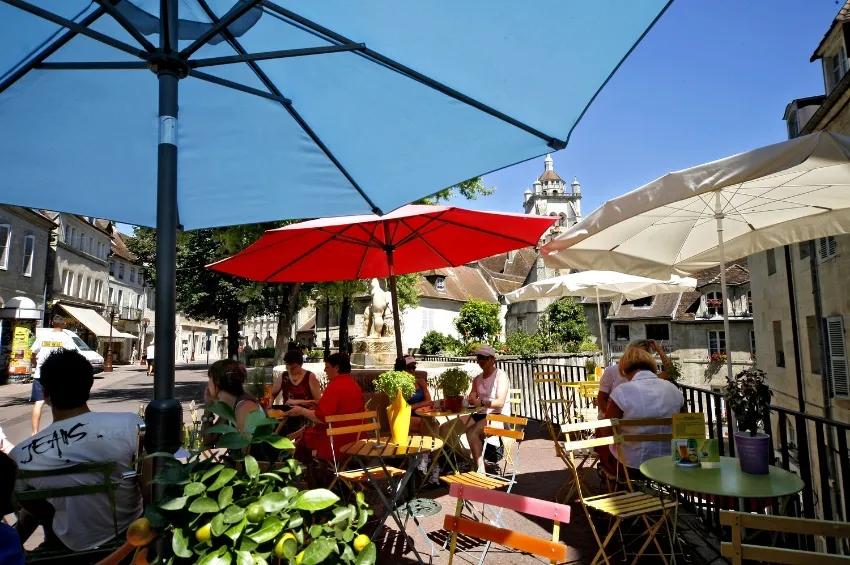
Discover Dole, the birthplace of Louis Pasteur, in the company of your guide as you follow the "trail of the Perched Cat”. This is a reference to the author Marcel Aymé, creator of the famous Contes du Chat Perché, who spent his childhood years in Dole. Perched on a limestone hillside alongside the canal, Dole was the capital of the County of Burgundy before it became part of the French kingdom in 1678. Along your tour, you will discover the many historic monuments which have granted Dole the City of Arts and History Label. You'll also get to see Louis Pasteur's birthplace which today houses a museum tracing the history of the scientist's life, the Cours Saint-Mauris, a garden where the fluid design of the lower section contrasts with the straight paths of its upper section. Enjoy the wonderful views over the Chaux forest from the garden's terrace. You will also be able to see the former Hôtel-Dieu, which was a hospital for the poor built in the 17th century. Since 2000 it has housed the town's media centre, municipal archives and Dole's Town of Arts and History heritage initiative. You will end your visit of Dole with the famous Collegiate Church of Notre-Dame, built between 1509 and 1580, whose bell tower dominates the historic town center. There are many other monuments that you will be able to admire during the tour as you discover this town which is steeped in history. Afterwards, enjoy some free time before returning on board at your own pace.
PLEASE NOTE
- Good walking shoes are recommended for this excursion.
- The order of the visits can change.
- Times are approximate.
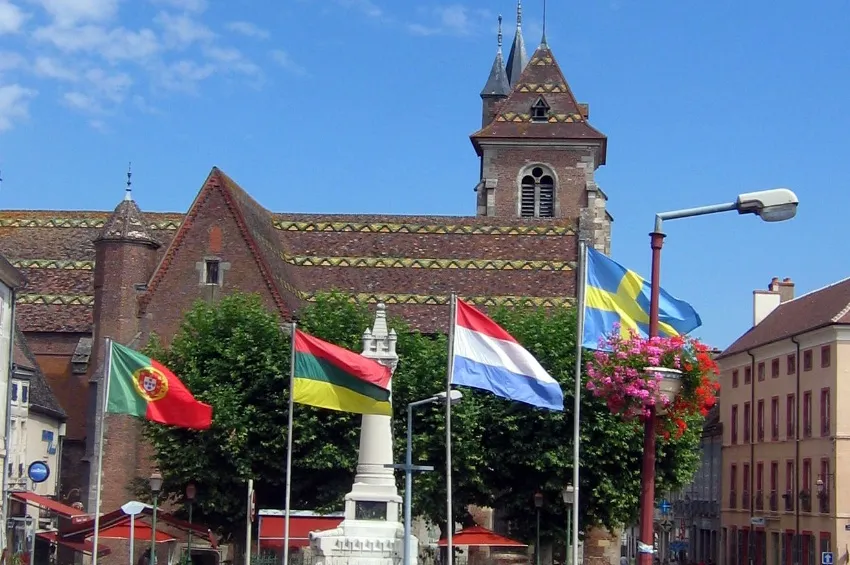
Saint-Jean-de-Losne is a small town with many monuments bearing testimony to a rich and prestigious past. Today it is the capital of barging in France, lying at the heart of the French waterways and canal system in southern Burgundy. With the help of a guided visit of the town, in the company of a registered guide, you'll discover the exterior of the Monument Commemorating the Siege of 1636 and the Hôtel-Dieu which was a hospital founded in 1658 enclosed by a wrought iron fence dating from the 17th and 18th centuries. You will also visit the Gare d'Eau (or Water Station), the Church of St John the Baptist, built during the 16th century in a mix of Gothic and Renaissance styles, and the Batellerie Museum (also known as the Sailors' House), one of the oldest houses in town, dating back to the 15th century which recounts the history of navigation. Your visit of the town ends at the Hotel de Ville, a former town hall built in the early 17th century, where you'll get the chance to taste some local specialties.
PLEASE NOTE
- Good walking shoes are recommended for this excursion.
- The order of the visits can change.
- Times are approximate.
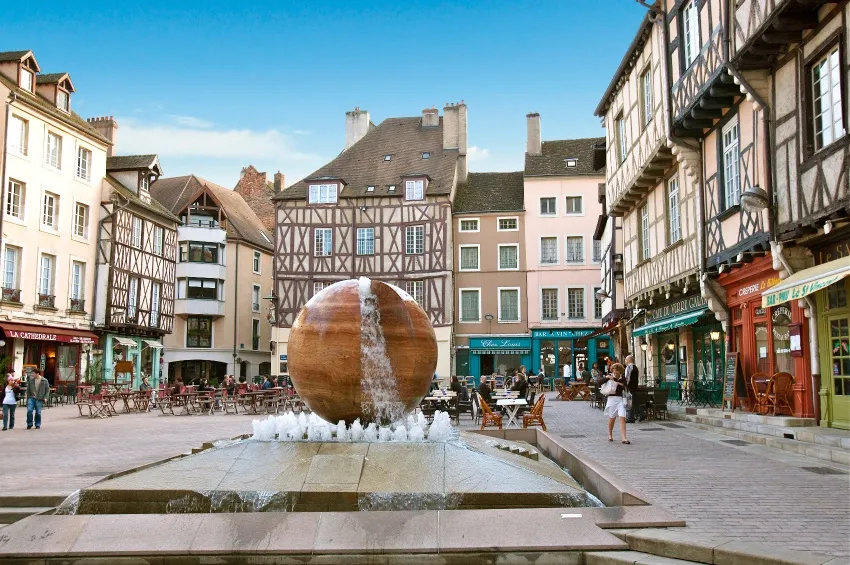
Set off on a discovery tour of Chalon sur Saône and its old town. Chalon came into being as the main port to the Eduens people during the Gaulish period and saw its glory days at the beginning of the Middle Ages as the Merovingian capital of Burgundy, and then again at the end of the same period as the site of famous international fairs. Joseph Nicéphore Niepce who invented photography was born in Chalon in 1765, one more reason to the town's fame. Today, Chalon is a city of Art and History, and as you wander around the Old Town you will be delighted by the half-timbered houses built between the 15th and 17th centuries, the restored facade of St Vincent's cathedral and fine classical mansions dating from the 17th and 18th centuries. Our visit will continue downtown where you will enjoy a tasting of local specialties from Burgundy. Return on board.
PLEASE NOTE
- Good walking shoes are recommended.
- The order of the visits can change.
- Times are approximate.
- *Alcohol can be harmful to your health. Please drink in moderation.
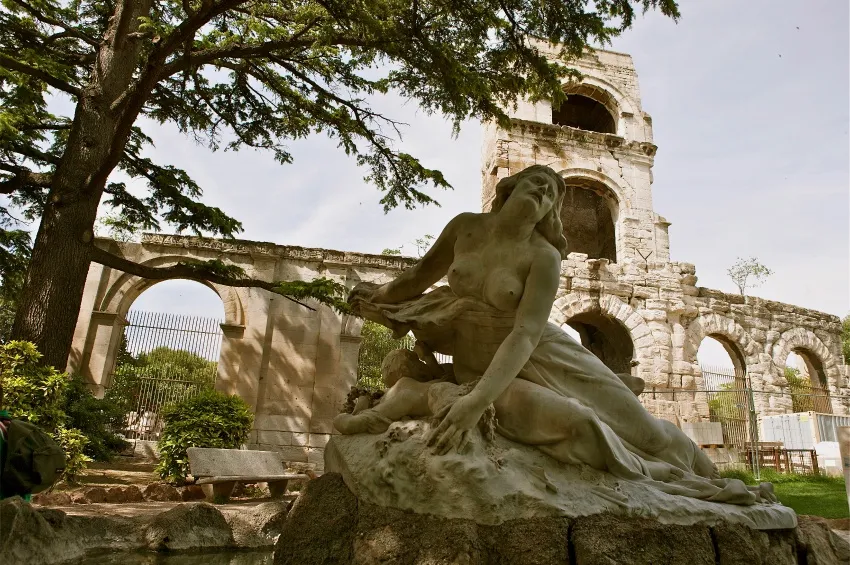
Set off on foot for a guided visit of Arles. Arles is over 2000 years old with exceptionally well-preserved ancient architectural masterpieces and is a real open-air museum. This important tourist and cultural site welcomes visitors with open arms. During the guided visit, you will see the Roman Amphitheatre (or Arena), the Theatre Antique and St Trophime Square with its cloisters and church that were part of the Arles Route, one of the three routes leading to Santiago de Compostela. We'll continue our tour with a visit to the Forum Square and finally the Roman Baths of Constantine. Next you will head off by coach for Tarascon to the Grand Servan estate, a traditional olive farm which produces the famous Provençal olive oil. Here at the foot of the Montagnette and set around a traditional Provencal farmhouse (or bastide) dating from the 18th century, the owners have planted a large orchard of some 150,000 olive trees. You will visit the estate sitting on bales of hay in trailers, pulled along by tractors. The owners will give you an explanation on how to plant and cultivate olive trees and how the Provençal "yellow gold”, or olive oil, is produced. Your visit will finish with a tasting of the products on the estate. Return to Arles by coach.
PLEASE NOTE
- Good walking shoes are recommended for this excursion.
- The order of the visits can change.
- Times are approximate.
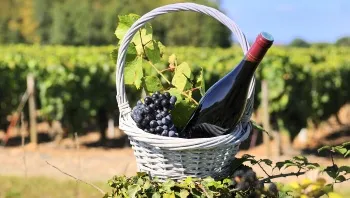
The rocky area to the south of Lyon is known for the lovely golden hues that glow differently as the sun moves across the sky. The area is as much a feast for the eyes as it is for your taste buds. Join us for a tour to discover the beauty of the region. We’ll visit a local vineyard for a tasting.*
PLEASE NOTE
- Good walking shoes are recommended.
- The order of the visits can change.
- Times are approximate.
- *Alcohol can be harmful to your health. Please drink in moderation.
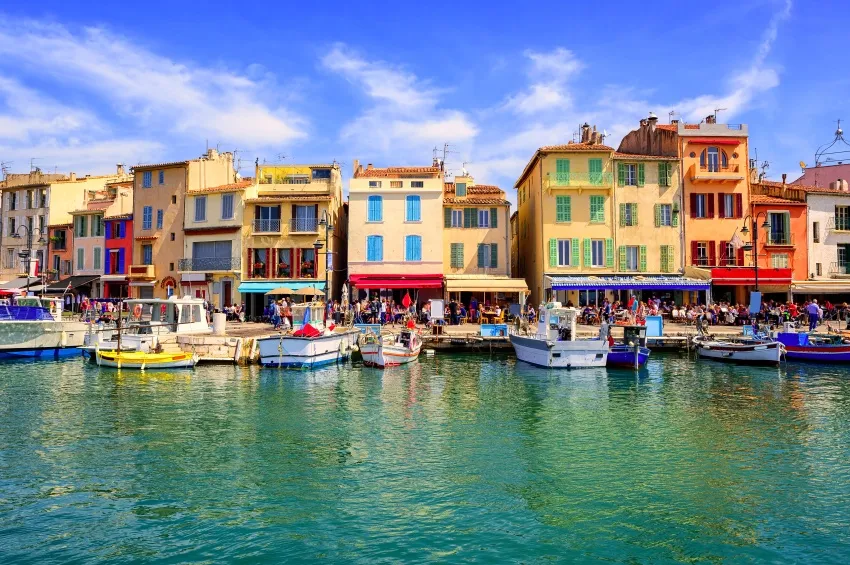
We'll leave by coach for Cassis, known for its crisp, floral, and flinty wines. Cassis wine is produced in 12 vineyards, all located in the hills immediately around the little town. We'll visit one of these vineyards for a tasting.* We'll return on board after our tour.
PLEASE NOTE
- Good walking shoes are recommended.
- The order of the visits can change.
- Times are approximate.
- *Alcohol can be harmful to your health. Please drink in moderation.

You'll set out on foot for a guided tour of the Papal Palace. Avignon was the seat of the papacy in the 14th century. The palace and surrounding buildings are now UNESCO World Heritage Sites. The most important site in the city has two sections: The Old Palace built by Pope Benedict XII and the New Palace built by his successor, Clement VI. During this tour, you'll visit the great halls once used for ceremonies and feasts, the painted chapels, the Pope's private residences, and the terraces with fantastic views of Avignon and the Rhône River. Afterwards, enjoy some free time to explore Avignon as the Christmas spirit begins to seep into the streets and transform them into a magical place.
We'll return on board on foot.
PLEASE NOTE
- The order of the visits can change.
- Times are approximate.
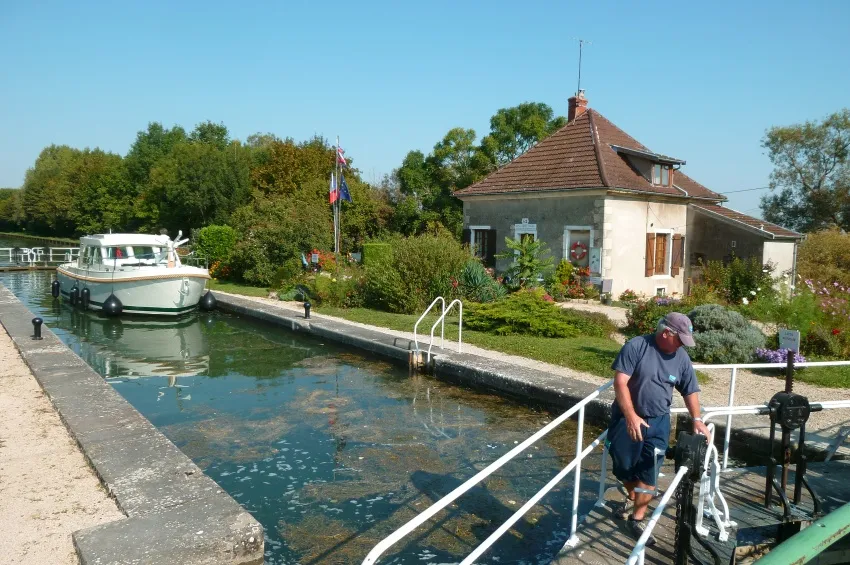
At the end of the afternoon, we'll arrive in Petit-Ouges where you can take the time to visit this tiny village at your own pace. Discover the surprising mini-museum dedicated to locks and its collection of photos, post cards and objects related to the Burgundy Canal. Have fun taking in the local curiosities.
You can also enjoy a four-kilometer hike on the "Path of the Three Wash Houses", exposing three historic wash houses in very different styles. This little known area of Dijon that traces its roots back to the 7th century will surprise you. We'll return on board for dinner.
PLEASE NOTE
- Wear comfortable, sturdy walking shoes for this excursion.
- The order of the visits can change.
- Times are approximate.
Departure on foot for a guided tour of the city, followed by the discovery of the International Santon Fair. The historic center of Arles is the vibrant heart of culture and history. Wander through its ancient alleys and discover a rich heritage that bears the marks of Roman influence and medieval grandeur. Then, head to the International Santon Fair, an unmissable event for enthusiasts of nativity scenes and santons from the south of France. With over 100 exhibitors and creators gathered in exceptional locations, the International Santon Fair showcases the finest santon craftsmanship and the masters of this discipline every year. For more than 60 years, Arles has celebrated the santon maker profession and this emblematic folk art. Free time before returning to the boat.
PLEASE NOTE
- The order of the visits can change.
- Times are approximate.
Your tour guide will meet up with you at the ship and escort you to visit a candle maker in Tarascon. Learn how candles have been made throughout the past century in this fascinating workshop.
PLEASE NOTE
- The order of the visits can change.
- Times are approximate.
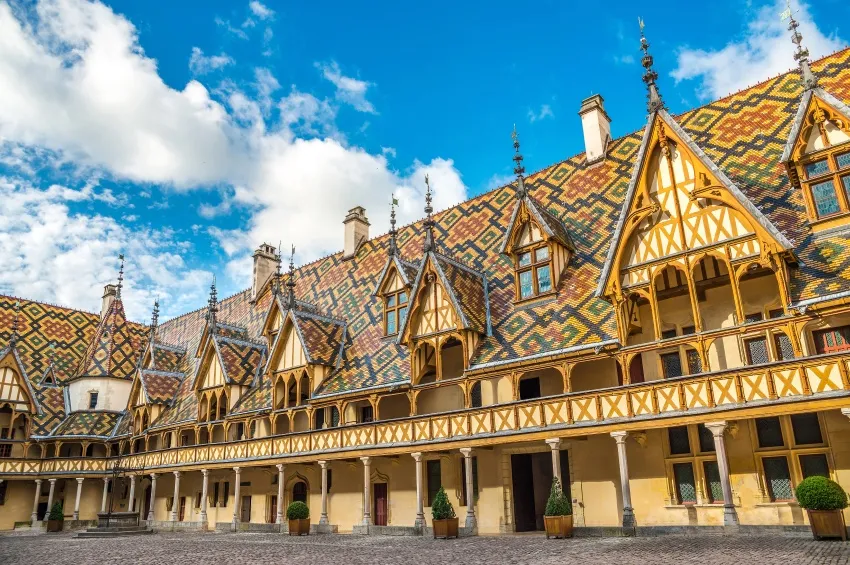
As we travel through the outlying hills of Beaune, we’ll cross through several well-known wine appellations: Pommard (once appreciated by Henri IV and Louis XV), Puligny, Montrachet, and many others. When we arrive in Beaune, we’ll first visit the famous hospice, founded by Chancellor Nicolas Rolin during the extreme poverty and plague that hit the region in 1443. It remained a working hospital overseen by the Holy See up through the 20th century, with the daily activities run by nuns known as Les Soeurs Hospitalières. Now a museum, it contains over 5,000 objects, including a dazzling polyptych altarpiece of The Last Judgment by Rogier van der Weyden. The hospice is also well known for their more than 148 acres of vineyards, most of which are located in prestigious appellation areas. As anticipated, our tour will finish up with a tasting of a selection of these wines.
PLEASE NOTE
- The order of the visits can change.
- Times are approximate.
- *Alcohol can be dangerous to your health. Please drink in moderation.
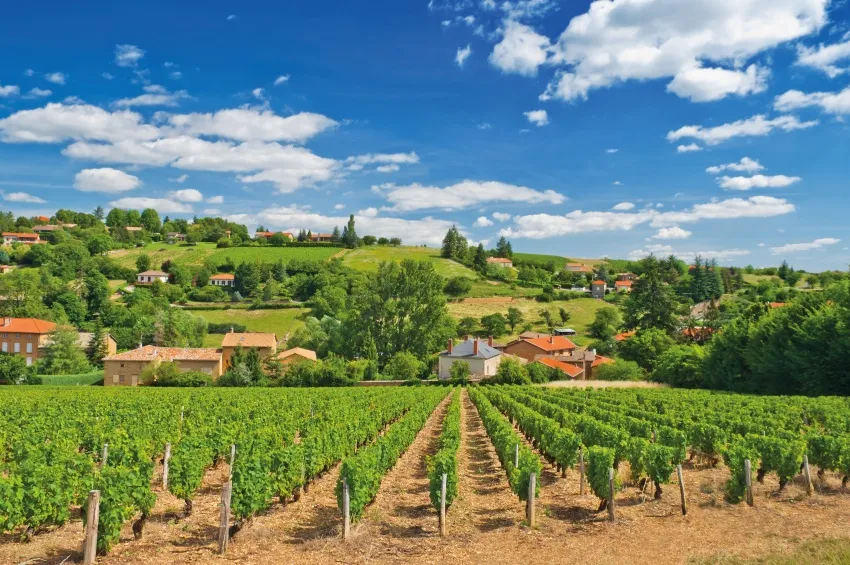
We’ll set out for Beaujeu, the former capital of the Beaujolais. The departure of the Beaujolais Nouveaux wine from the Les Sarmentelles International Festival is a joyful, 30-year-old event. You’ll be able to join in on the action and discover the 12 appellations of Beaujolais while listening to great music and admiring the fantastic scenery and quaint architecture of the tiny city. In the evening, we’ll enjoy the famous “soirée prestige” in the center of it all, where cabaret shows and dinner prepared by the best chefs in the region await you under outdoor tents. At midnight, we'll set off on a torch-lit stroll to welcome Beaujolais Nouveau Day and watch a fireworks show.
PLEASE NOTE
- The order of the visits can change.
- Times are approximate.
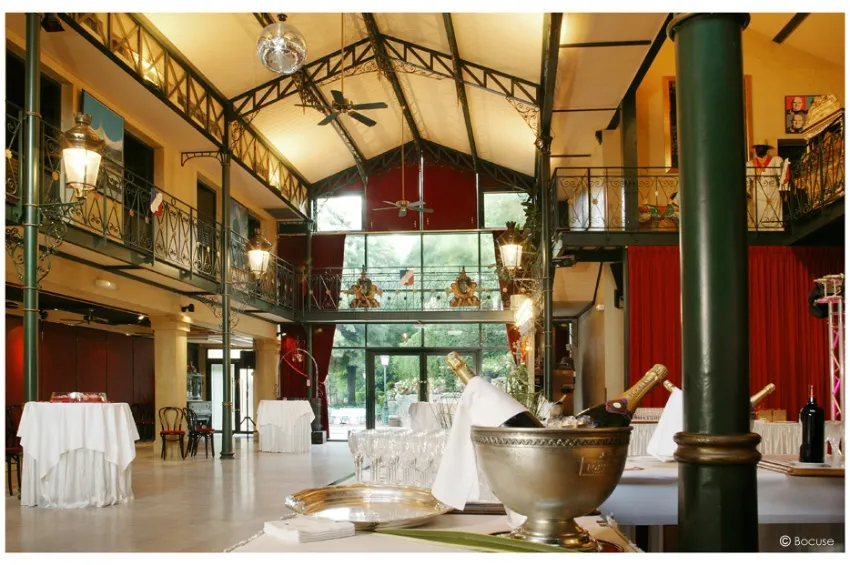
We’ll leave on foot for Paul Bocuse’s Abbaye de Collonges for a veritable French feast. Paul Bocuse was a three-star gourmet chef who was known for his innovative approach to cuisine and his love for fresh, high-quality ingredients. This will be a singular experience in an exceptional setting, where you’ll be able to relish in out-of-this-world courses prepared by some of the most renowned chefs.
SAMPLE MENU
- 4-part House Cocktail Surprise (hot and cold)
- Traditionally prepared foie gras, chutney, and brioche toast
- Lobster cassolette with diced vegetables
- Beaujolais winegrowers’ granita
- Veal steak, Smitane sauce, spinach sautéed in butter
- Mère Richard Saint Marcellin and fresh, churned goat cheese
- Sweets and treats
- Petit fours and chocolates
DRINKS INCLUDED
- House cocktail (Burgundy sparkling wine, blackcurrant and raspberry liqueur)
- Les Dames Blanches du Sud - Domaine de Grangeneuve
- Lubéron - Michel Chapoutier wines
- Mineral water
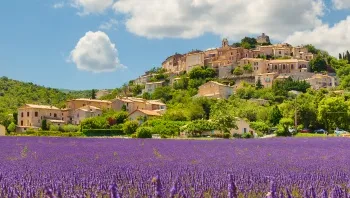
We'll travel by coach to one of the most beautiful villages in France, Les Baux-de-Provence, located on a plateau in the heart of the Alpilles mountain range. The village overlooks the exceptional scenery leading to Arles, the Camargue, and the Alpilles Regional Nature Park. Les Baux is one of the must-see sites when visiting Provence. The village became well known after World War II when Raymond Thuillier opened the gastronomic restaurant “Oustau de Baumanière,” which welcomed celebrities and famous politicians at the time. The entire village was placed under the protection of the French Ministry of Culture and Environment in 1966. Since then, it has become the ultimate tourist destination and has been listed as one of France’s most beautiful villages.
At the foot of the village lies the Val d’Enfer, a valley formed by erosion. Within the valley is an old limestone quarry that was used to build the village and was the inspiration or backdrop for many works, including Dante’s poem The Divine Comedy and Jean Cocteau’s Testament of Orpheus. Today, it serves as the scene for a giant multimedia show where music and colors bring to life the amazing works of Picasso, Klimt, and Van Gogh. After our excursion, we’ll return on board the ship.
PLEASE NOTE
- The order of the visits can change.
- Times are approximate.
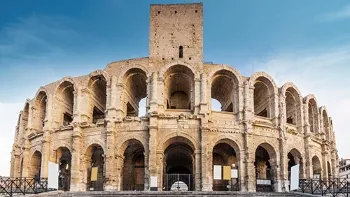
We’ll leave on foot for a guided tour of Arles following the footsteps of Vincent Van Gogh. Arles is an ancient Roman city whose ruins are second only to Rome and include the Antique Theater, Amphitheater, Thermes of Constantine, and the Alyscamps. Arles is also an important stop along the Way of St. James. Vincent Van Gogh came to Arles to escape the gray winter in Paris and the indifference he felt within the artistic milieu there. He arrived in Arles on February 20, 1888, and immediately began to produce his most prolific number of works in his career: more than 300 paintings and drawings within an 18-month period. Van Gogh crisscrossed the city and its surroundings to paint the landscapes, people, and scenes as he interpreted them. Everything around him served as inspiration for his canvases. Our tour will retrace his steps to the different sites where he set up his easel, such as the Place du Forum, the Quai du Rhône, and Place Lamartine. Panels at each stop compare his painting and the actual scene as it appears today. After some free time on your own, we’ll return to the ship.
PLEASE NOTE
- The order of the visits can change.
- Times are approximate.
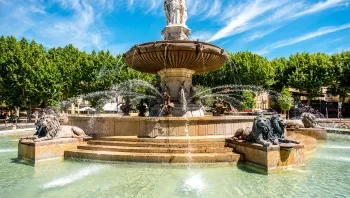
We’ll leave by coach for Aix-en-Provence. At the foot of Mount Sainte-Victoire and surrounded by impeccably preserved countryside dotted with Provençal fortified towns, lies Aix-en-Provence. Mount Sainte-Victoire itself is a symbol of the bucolic landscapes so many artists have used as inspiration. Aix-en-Provence was founded by the Romans in 123 BC and is considered the historical capital of the region. Aix today shows off its rich architectural heritage through the superbly restored and maintained bourgeois homes, small squares bursting with flowers, private mansions, and ancient fountains. Paul Cézanne, whom many consider the father of modern art, was born here. We’ll follow the footpath marked with “C” from the home where he was born to his final resting place. This tour takes you to the highlights of his childhood as well as the cafés where he found inspiration among his friends and fellow artists. At the end of our stroll, we’ll enjoy a tasting of the city’s most famous delight, the Calissons.
PLEASE NOTE
- The order of the visits can change.
- Times are approximate.
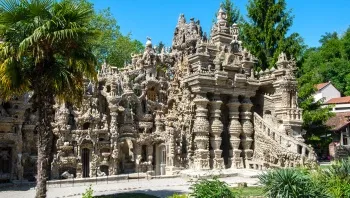
We’ll head out on an excursion to the Palais Idéal du Facteur Cheval, a monument built by a postman from 1879 to 1912. No other building like it exists in the world, which is why it attracts the curiosity of visitors from all over. Cheval’s challenge began in 1879 when he tripped over a stone. He took the stone home with him to examine its structure closer. The next day he went back to the same spot and found more sandstones that had been sculpted by nature. For the next 33 years, he picked up stones during his daily rounds and brought them home to add to his palace. In addition to building the structure with his own hands, Ferdinand Cheval personalized the palace with poetic texts describing his feat. After our excursion, we’ll return on board the ship.
PLEASE NOTE
- The order of the visits can change.
- Times are approximate.
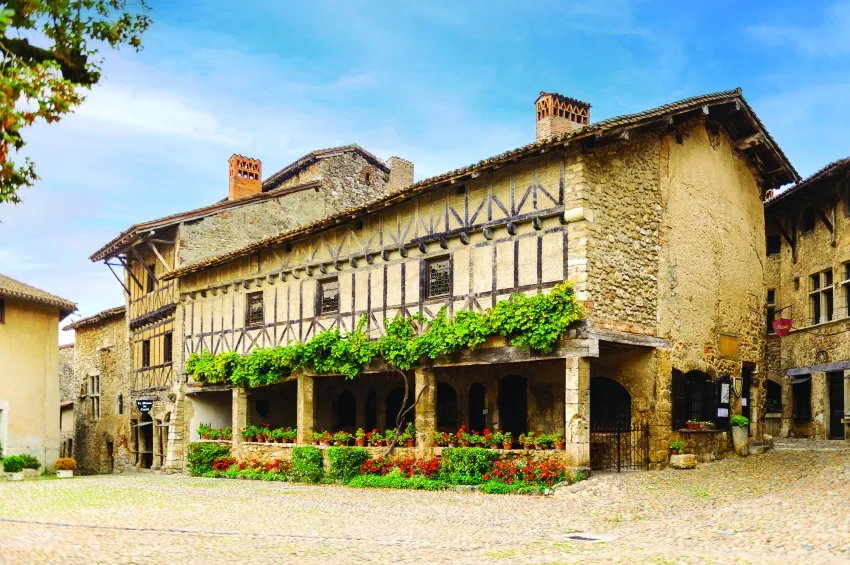
We’ll leave Belleville by coach for the medieval city of Pérouges, listed as one of the most beautiful villages in France. Pérouges sits atop a small hill that overlooks the Ain River in the distance. The cobblestone streets and medieval homes were built over six centuries ago and truly feel like something straight out of a classic novel. The Place du Tilleul, home to a linden tree that is over 220 years old, is the quintessential spot to take in the village’s timeless charm. Tasting of local products. We’ll return on board in Trévoux.
PLEASE NOTE
- The order of the visits can change.
- Times are approximate.
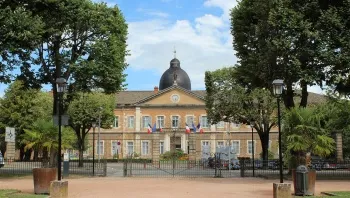
Alphonse de Lamartine was born in Mâcon in 1790. He was an author, poet, and statesman who had a profound impact on France during the 19th century. We’ll set out to trace his footsteps by following the bronze “Plume Trail” that will take us through the charming downtown streets to the city’s most important, historical monuments, which include the statue of Alphonse de Lamartine on the banks of the river, the Wooden House, Ursuline Museum, Mâcon Cathedral, and Saint Peter’s Church. Enjoy some free time before returning to the ship. We’ll return on board on foot.
PLEASE NOTE
- The order of the visits can change.
- Times are approximate.
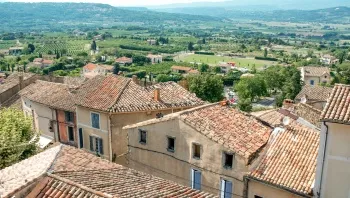
We’ll set off on a tour that includes areas of the beautiful Alpilles Natural Regional Park and the vines that produce the classic Baux-de-Provence wines. The red and rosé wines are produced mostly from the Grenache, Syrah, and Mourvèdre varieties, giving them aromas that include blackberry, violet, black olives, and herbs. We’ll visit Saint-Rémy-de-Provence, located in the Alpilles Natural Regional Park, a quintessential Provençal village bursting with French charm. We’ll visit a local vineyard for a tasting.*
PLEASE NOTE
- Good walking shoes are recommended.
- The order of the visits can change.
- Times are approximate.
- *Alcohol can be harmful to your health. Please drink in moderation.
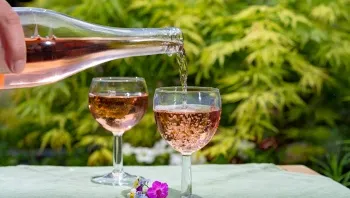
The Côtes de Provence region is best known for its crisp rosé wines and magnificent scenery. Provence was one of the very first regions to cultivate grapevines for wine production almost 2,600 years ago. Today, vineyards extend along the coastline and deep inland. The strong mistral winds are key to its great success. We’ll visit a local vineyard for a tasting.*
PLEASE NOTE
- The order of the visits can change.
- Times are approximate.
- *Alcohol can be harmful to your health. Please drink in moderation.
Departure on foot to the Château de Tarascon. Built in the first half of the 15th century, the Château de Tarascon is one of the most beautiful fortresses in France. It is a perfect example of a building that, through its architecture and decor, combines Gothic and Renaissance styles. Built on a low rock at the crossroads of land and river routes connecting Provence to Languedoc, the château once served as a monumental sentinel. Its terrace offers breathtaking views of the river, the plains, the Alpilles, and the Montagnette. The château's remarkable state of preservation is due in large part to restoration and maintenance work carried out by several State historical monument architects. During your visit to the Château, you will discover the apothecary of the Saint-Nicolas hospital, more than 30 rooms, and an exceptional panorama of the Rhône and Provence from the château's immense terrace. Return on foot to the boat.
PLEASE NOTE
- The order of the visits can change.
- Times are approximate.
Departure by coach to Les Baux-de-Provence. This village, perched on a rocky spur, boasts an incredibly rich architectural heritage. A true eagle’s nest in the heart of the Alpilles, Les Baux-de-Provence is a must-see Provençal destination, brought to life year-round by artists, artisans, and producers. Its citadel overlooks natural sites of extraordinary beauty. Visit the village and the Museum of Santons, which houses a significant number of pieces from various collections, including a traditional Provençal Nativity scene and displays of the daily life of a 19th-century family presented in two large showcases. Return to Arles for a guided tour of the city before discovering the International Santon Fair, the must-attend event for Nativity scene and santon enthusiasts in the south of France. Created by artisans in 1958 to showcase the craftsmanship of santon makers, the fair now gathers more than 100 exhibitors and creators each year. Free time before returning to the boat.
PLEASE NOTE
- The order of the visits can change.
- Times are approximate.
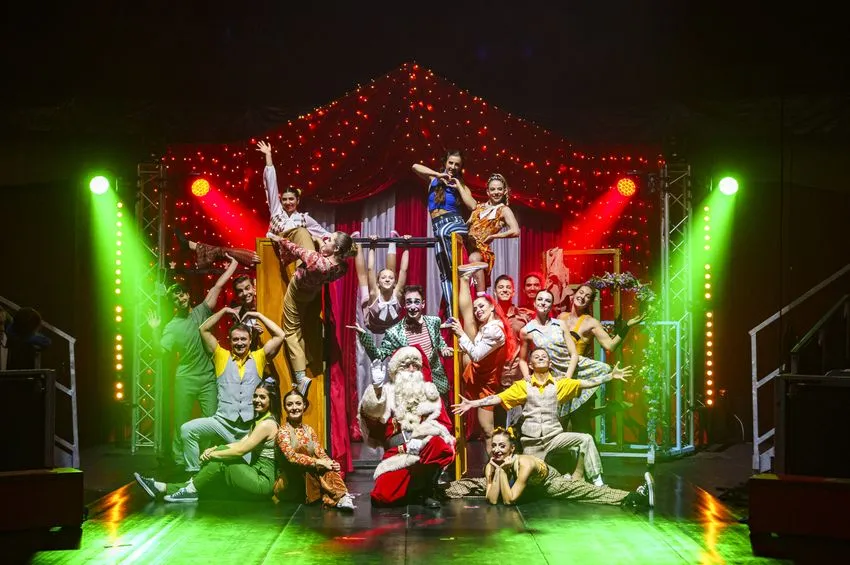
Cirque Imagine - Christmas Show. In a warm and magical atmosphere, you will be transported by a show combining breathtaking acrobatics, elegant aerial performances, spectacular juggling, and charming clowns. Under the twinkling lights and to the sound of enchanting music, the talented performers showcase their feats to delight the audience. Return to the boat. For those who wish, take this opportunity to explore the nearby Christmas markets, just a short walk from the boat. Return on board to prepare for the Christmas Eve dinner. At the end of the meal, you can attend the Christmas mass in Lyon (1).
PLEASE NOTE
- (1) Transfer option: €25 per person, reservation and payment on board. The transfer is only offered when the boat is not docked near the place of worship.
- The order of the visits can change.
- Times are approximate.
Departure by coach to Saint-Rémy-de-Provence. Nestled in the heart of the Alpilles, Saint-Rémy-de-Provence is a Provençal gem that charms visitors with its sunny climate, offering more than 300 days of sunshine per year, and its timeless appeal. Known for having inspired great artists, including Vincent van Gogh, this small Provençal town offers an idyllic setting that blends nature, art, and authenticity. Strolling through the narrow streets of the historic center, you will immerse yourself in the true Provençal way of life. You will be enchanted by its picturesque little squares, such as those of Jules Pellissier and Camille-Dourguin, adorned with fountains. Saint-Rémy is also an artistic pilgrimage site for admirers of Vincent van Gogh. The town is home to over 150 of his iconic works. Then, head to Saint-Paul de Mausole, the former monastery where Van Gogh stayed, offering insight into the influence Provence had on his work. Located at the foot of the Alpilles, Saint-Paul de Mausole has been a monastery since the year 1000. It has hosted monks from various congregations over time. Among other things, you will discover the Romanesque cloister and its garden, as well as the recreation of Van Gogh's hospital room during his stay at Saint-Paul from May 1889 to May 1890. Return to the boat.
PLEASE NOTE
- The order of the visits can change.
- Times are approximate.
At the crossroads of the Alpilles, Montagnette, and Camargue, Tarascon has all the qualities of a Provençal town, built along the Rhône River at the heart of the golden triangle of Nîmes, Arles, and Avignon. Departure on foot towards the historic center of the old town to discover its heritage. The town center invites you to enjoy its relaxed way of life, its beautiful architecture, sober and elegant, and its pedestrian streets. Don’t miss the Tarasque, a mythical creature from Provence, said to be the origin of the town's name. Then head towards Les Baux-de-Provence and its Santon Museum. This village, perched on a rocky spur, boasts an incredibly rich architectural heritage. A true eagle’s nest in the heart of the Alpilles, Les Baux-de-Provence remains an unmissable Provençal destination, brought to life year-round by artists, artisans, and producers. Its citadel overlooks natural sites of extraordinary beauty. Visit the village and the Santon Museum, which houses a large number of pieces from various collections, including a traditional Provençal Nativity scene and the daily life of a 19th-century family displayed in two large showcases. Return to Tarascon.
PLEASE NOTE
- The order of the visits can change.
- Times are approximate.
At the crossroads between the Alpilles, Montagnette, and Camargue, Tarascon boasts all the charms of a Provençal town, built along the banks of the Rhône at the heart of the "golden triangle" of Nîmes, Arles, and Avignon. Depart on foot to the historic heart of the old town to explore its heritage. The city center invites you to enjoy its gentle lifestyle, beautiful architecture—simple and elegant—and its pedestrian streets. Don’t miss the Tarasque, the mythical creature of Provence that is said to have given the city of Tarascon its name. Then, visit the Royal Collegiate Church of Sainte Marthe, located in the heart of Tarascon. This Romanesque church, founded in the 11th and 12th centuries, is dedicated to Sainte Marthe. Legend has it that Marthe arrived in 48 AD in this city plagued by a terrifying creature, the Tarasque, which the Saint tamed. Many pilgrims still visit the Collegiate Church of Sainte Marthe, where you can admire its crypt, its organ, and its superb collection of works by great masters. The collegiate church is a major pilgrimage site, attracting the faithful for centuries, and remains an iconic monument of Provence. Return to the boat on foot.
PLEASE NOTE
- The order of the visits can change.
- Times are approximate.
The historic center of Arles is the vibrant heart of culture and history. Stroll through its ancient streets and discover a rich heritage that reflects its Roman legacy and medieval grandeur. Then, head to the Church of Notre-Dame-de-la-Major, located a few dozen meters west of the Arenas. This is the church traditionally frequented by the shepherds of Crau and the Camargue cowboys (gardians). It serves as the headquarters of the Brotherhood of Saint George's Gardians, whose statue is displayed in a niche. A ceremony and celebration in his honor are held on May 1st. There, you will also see a magnificent Nativity scene. The creator of this Provençal crèche is an enthusiast who began his work in 1992. Every year, he installs a monumental Nativity scene in the side aisle of this beautiful church, featuring at least 750 santons, along with intricate decorations and scenes from Provençal life. This magnificent work is undoubtedly one of the most beautiful in Provence, paying tribute to Arles, a Provençal city proud of its traditions.
PLEASE NOTE
- The order of the visits can change.
- Times are approximate.
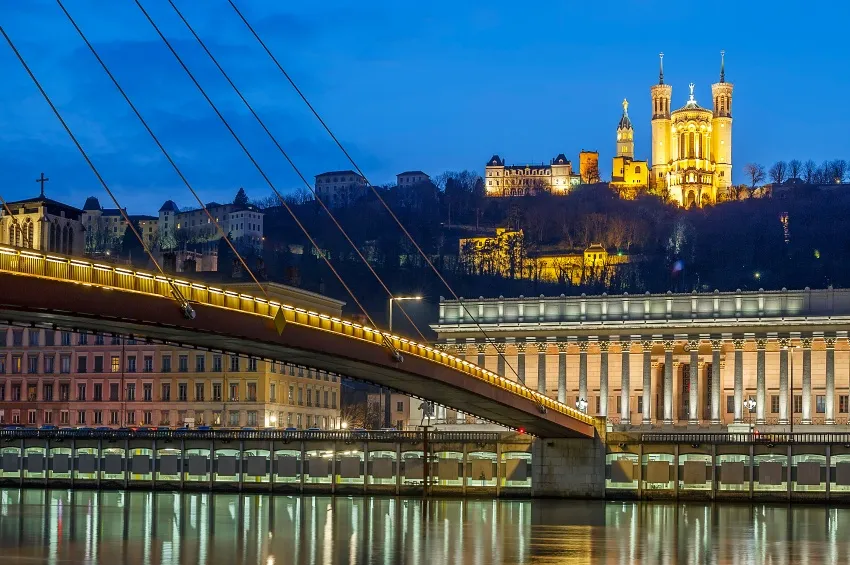
This winkling city will reveal itself to you during a guided visit by coach and on foot. Our excursion will start with a stop at the Fourvière Basilica. You'll first take in the breathtaking views from the heights of the Basilica before entering it. In 1168, a chapel was built in Fourvière by Olivier de Chavannes, the Saint Jean canon, over the ruins of the old roman forum. The small chapel that was first dedicated to Saint Thomas and then to the Virgin Mary has been destroyed and rebuilt many times. Its current known form dates back to 1740 and its most recent renovation was in 2008. After our visit we'll return to the coach and move on to Lyon's Old Town. You will take a walking tour with our guide and discover the "traboules”, types of passageways that are typical of the city. The first traboules are thought to have been built in the 4th century. There was a water shortage in Lugdunum (the Gallo-Roman name that was given to Lyon at the time) that led its inhabitants to settle in the "lower city” on the banks of the Saône, at the foot of the hills of Fourvière. The traboules were thus used to reach the river quickly. You'll enjoy some free time in the Saint Jean district, in the heart of the Old Town. Return on board for lunch.
PLEASE NOTE
- The order of the visits can change.
- Times are approximate.
- Good walking shoes are recommended.
- Please dress appropriately to enter the Basilica.

Although it is still in the Burgundy region, with its unique roof tiles and brightly colored facades, Mâcon feels like it should border the Mediterranean Sea.
The city has a wide range of striking monuments and beautiful, old mansions lining the streets in the older sections.
PLEASE NOTE
- The order of the visits can change.
- Times are approximate.
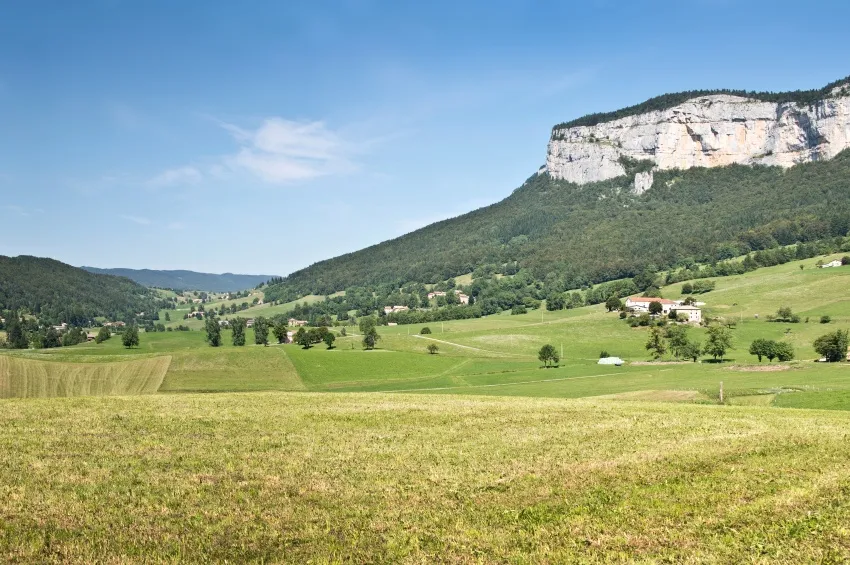
Departure by coach from La Voulte towards Die. Carved out in limestone, the Vercors Regional Nature Park extends over 186,000 hectares between the Isère Valley to the North and the Diois to the South. Water has shaped deep gorges in the cliffs, majestic cirques, caves and chasms among the most famous in Europe. Wooded plateaux and valleys shaped by agriculture are home to a remarkable fauna and flora.
We'll stop at the cellars of Die Jaillance to discover a true love story between men and the vines and enjoy a wine tasting session.* Afterwards, we will continue by coach for a panoramic view of the Rousset Pass located in the heart of the Vercors and reaching an altitude of over 1400 meters. The belvedere culminates at a height of 1245 meters and from this point of view the scenery is outstanding: arid escarpments and a road with hairpin bends down the hill, which accentuates the overall impression of depth. We'll move on towards Vassieux-en-Vercors, La Chapelle-en-Vercors and Pont-en-Royans where you'll get to see the suspended houses, whose daring architecture dates as far back as the perched village itself, built in the 15th century. Last, we'll drive through Romans-sur-Isère well known for its shoe industry before returning by coach to Tain l'Hermitage to board our ship.
PLEASE NOTE
- Roads are sinuous, beware of travel sickness.
- The order of visits can be modified.
- Times are approximate.
- *Alcohol can be harmful to your health. Please drink in moderation.
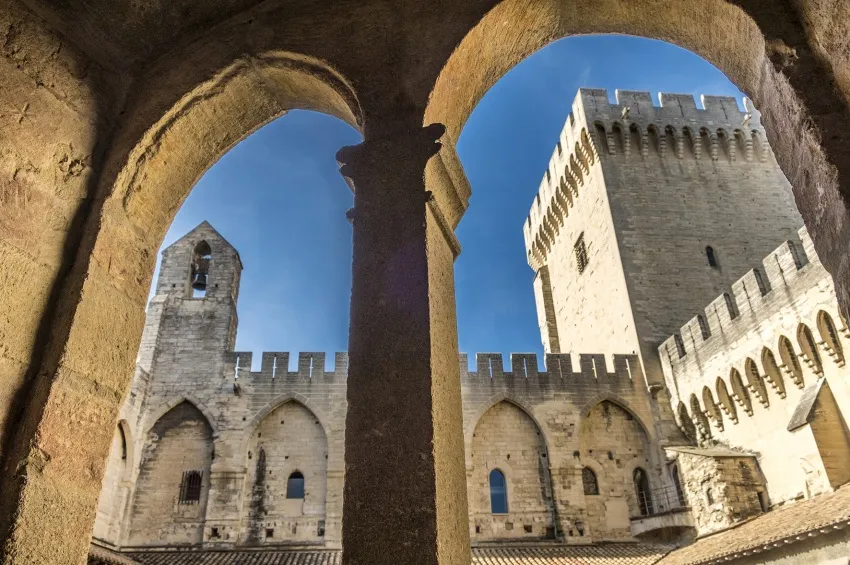
The Papal Palace is a magical place for everyone'young and old. Adults will adore its grandeur. Curious kids will find the secrets hidden within its impressive walls intriguing. Is it a castle? A palace? A fortress? Set off on a fun-filled tour and discover for yourselves!
PLEASE NOTE
- It is forbidden to take pictures inside the Pope's Palace.
- It is necessary to climb up 500 steps inside the Pope's Palace.
- Bags would be left in the luggage office.
- Good walking shoes are recommended.
- Times are approximate.
- The order of the visits can change.
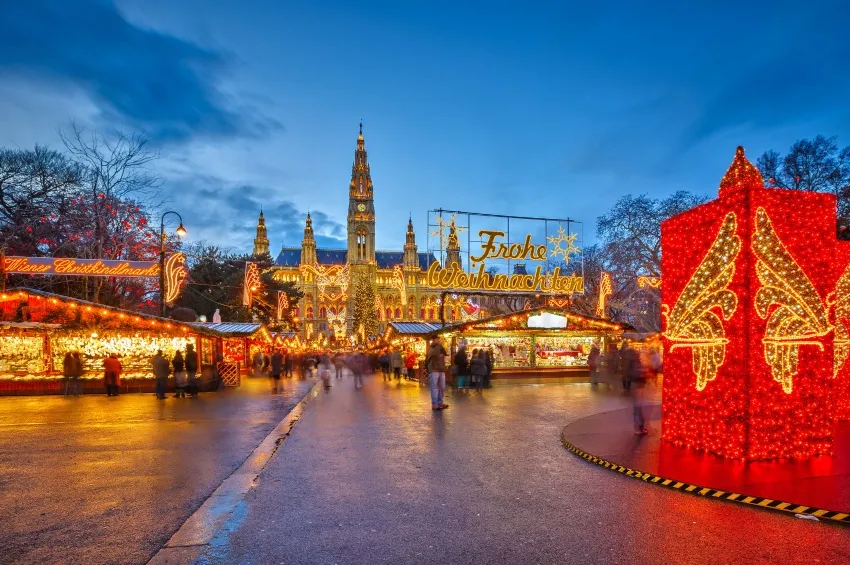
Meet up with the guides for a guided walking tour of Vienne, during which you will discover this Roman city rich in vestiges. The history of Vienna goes back more than 2000 years. The city is indivisible from the Rhône river and the surrounding hills. The Allobrogi people are thought to have made it their capital, but it was in the Roman era that the city began to prosper on both banks. You will see the Antique Theatre; built roughly between 40 and 50 AD, it is considered one of the largest in the Roman empire, with its 130m diameter and 13,000 spectators capacity. Restored in 1938, it was returned to its original function and is now a venue for artistic events. The tour will continue with the Temple of Augustus and Livia (exterior only). This temple dedicated to Rome and Augustus stood in a sacred area on the forum and has carried this name since the end of the 18th century. Its construction began about 20-10 BC; it was later transformed at the beginning of the Middle Ages into a church, and was finally restored in the second half of the 19th century thanks to the intervention of Prosper Mérimée. Finally, to complete the tour, you will see the Cathedral of St Maurice (exterior only), which has been listed as a historic monument since 1840. Return to the boat on foot.
PLEASE NOTE
- The order of the visits can change.
- Times are approximate.
- Good walking shoes are recommended.
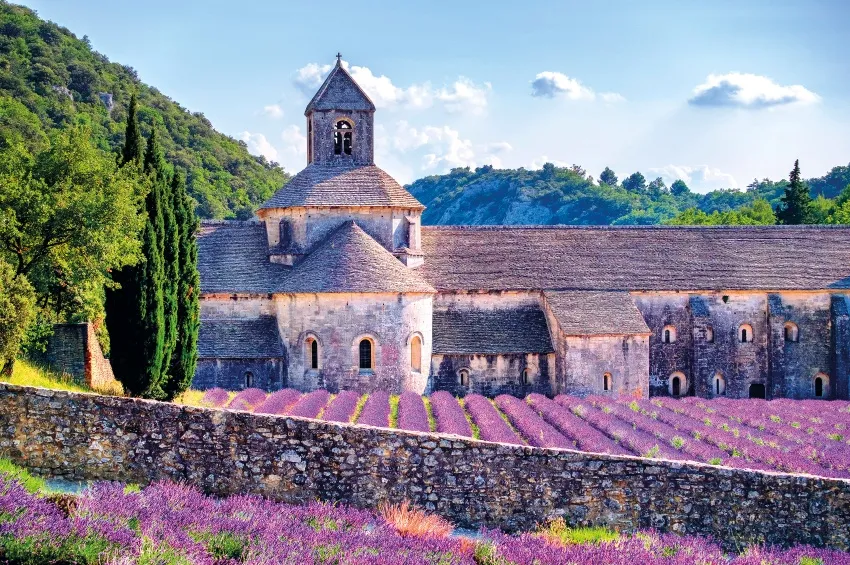
Leave by coach for an optional tour of interesting sites in the Luberon area. You will see the village of Gordes, awarded the label "One of the Most Beautiful Villages in France." Located in the heart of the Vaucluse hills and the Luberon Regional Natural Park, Gordes and its majestic château dominate the valley. Admire the beauty of the village dotted with stone houses perched atop limestone cliffs. Arrival at the Sénanque Abbey, a fantastic example of Cistercian work. The abbey was founded in 1148 by Cistercian monks from Mazan, located in the Ardèche region. The abbey church forms a tau cross, and rather unusually, its traditional liturgical east end actually faces north. The monastery took 60 years to build, and the oldest parts of the complex were built with local stones. The monks of today continue to uphold their monastic tradition of lives dedicated to prayer and labor as dictated by the Rule of Saint Benedict. The community gathers in the church seven times a day to celebrate collectively. Each monk performs a duty within the structure of the monastery, which itself is focused on the cultivation of lavender. After the flower is harvested in July and August, the monks extract the scent as an oil, which they then use to produce various products, including perfume.
In the case of unavailability, the visit to the abbey will be replaced by a visit to the Lavender Museum:
The Lavender Museum is located in the heart of the Golden Triangle, near Gordes. This picturesque museum, in the form of a traditional local dry-stone farmhouse, houses a veritable conservatory of fine Provençal lavender. More than 346 exhibits retrace the history of lavender in Provence from the 16th century to the present day. You'll be plunged into the spellbinding world of this plant that is so emblematic of Provence. The tour begins with an introduction to the history of lavender, where you'll discover how it has been used throughout the ages, both culinarily and medicinally. Interactive exhibits will enable you to learn more about the different varieties of lavender and their specific characteristics. Next, you can explore the various stages in the distillation of lavender essential oil, and to round off this sensory experience you'll have the chance to smell and test the lavender essential oil.
At the end of our tour, we’ll return to the ship.
PLEASE NOTE
- The order of the visits can change.
- Times are approximate.
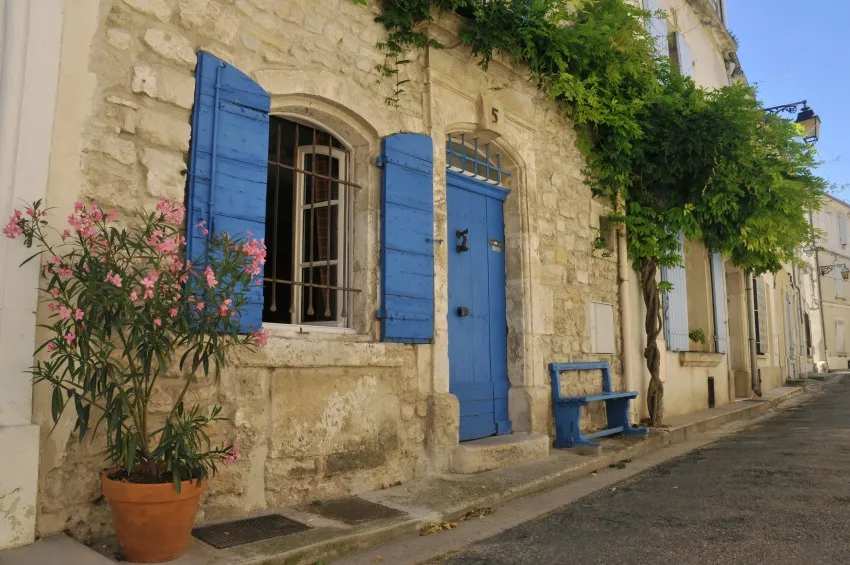
Depart by foot for the guided tour of Arles. For two thousand years Arles has maintained an outstanding architectural heritage making it a genuine open-air museum. Welcome to this tourist and cultural mecca. During this tour you will see the Roman Amphitheatre (the Arena), the Roman Theatre, St Trophimus square with its cloister and church on the Arles route; one of three routes leading to Santiago de Compostela. We will continue our tour through the Place du Forum, and finally, the Roman baths of Constantine. Then, depart by coach towards Tarascon. You will visit a domain producing the famous Provencal olive oil at the foot of Montagnette in an 18th C. Provençal country house where the estate owners have planted a large orchard of 150,000 trees. You will visit the estate sitting on straw bales in trailers pulled by tractors. The owners will explain the cultivation and production of the yellow gold of Provence, olive oil. After this discovery, you will have the opportunity to taste the products of the estate. Return to Arles by coach.
PLEASE NOTE
- Good walking shoes are recommended.
- The order of visits can change.
- Times are approximate.

You will set out on foot for the guided tour of the old town of Avignon. With the Pope's Palace, classed as a world heritage site by UNESCO and a testimony to the city's past when it was known as the capital of Christianity back in the Middle-Ages, Avignon offers an impressive array of monuments. Along the Passage de l'Oratoire, you'll be able to admire the exteriors of the chapel, classified as a historic monument, where many events take place during the famous Avignon Festival. We'll move on to St Agricol street where you'll get to see the diocesan Church, the oldest in the city. We'll then stop by the Place de l'Horloge, which has always been the beating heart of Avignon. Cafés and restaurant terraces are now spread out where the Roman forum once stood. Right across, you will see the walls of the Town Hall and the theater that was built in the 19th century. We'll continue to the Place du Palais. This square is roughly 800 ft long and 160 ft wide. To the East stands the Pope's Palace which faces the baroque sculptures of the Papal mint. A large golden Virgin seems to be watching the Notre Dame des Doms cathedral while the elegant Renaissance inspiration on the outside walls of the Petit Palais are showing further back. Then, discover the Pope's Palace, the most important monument in the city. It's made of two parts: the old Palais of Pope Benedict XII (1334 - 1342), and the new Palais of his successor Pope Clement VI (1342 - 1352). Our visit will take you through the staterooms where numerous ceremonies and feasts took place, the chapels, the Pope's private apartments and the terraces which offer a wonderful panorama on Avignon and the Rhône river. Return on board on foot.
PLEASE NOTE
- It is forbidden to take pictures inside the Pope's Palace.
- It is necessary to climb up 500 steps inside the Pope's Palace.
- Bags would be left in the luggage office.
- Good walking shoes are recommended.
- Times are approximate.
- The order of the visits can change.
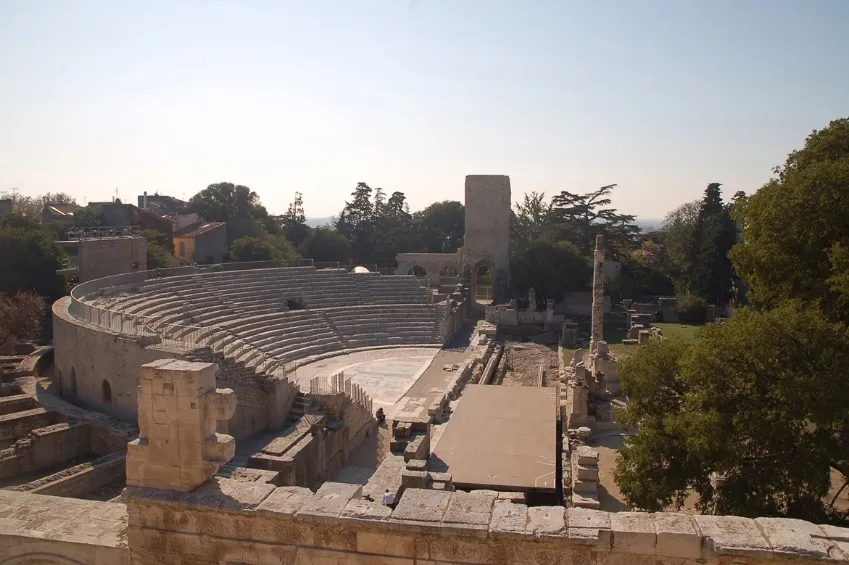
Departure on foot for the guided tour of Arles. Arles with its two thousand years of history has preserved an exceptional monumental heritage, making the city a veritable open-air museum. Welcome to one of the most important tourist and cultural sites in France. During the course of this guided tour you will see the Roman Amphitheatre (the "Arènes"), the Ancient Roman Theatre, Place St Trophime with its cloister and church, which are part of the Arles route, one of the three pilgrimage routes leading to Santiago de Compostela. We will continue our visit with Place du Forum and finally, the Thermae of Constantine. Free time. Return to the boat on foot.
PLEASE NOTE
- Good walking shoes are recommended.
- Times are approximate.
- The order of the visits can change.
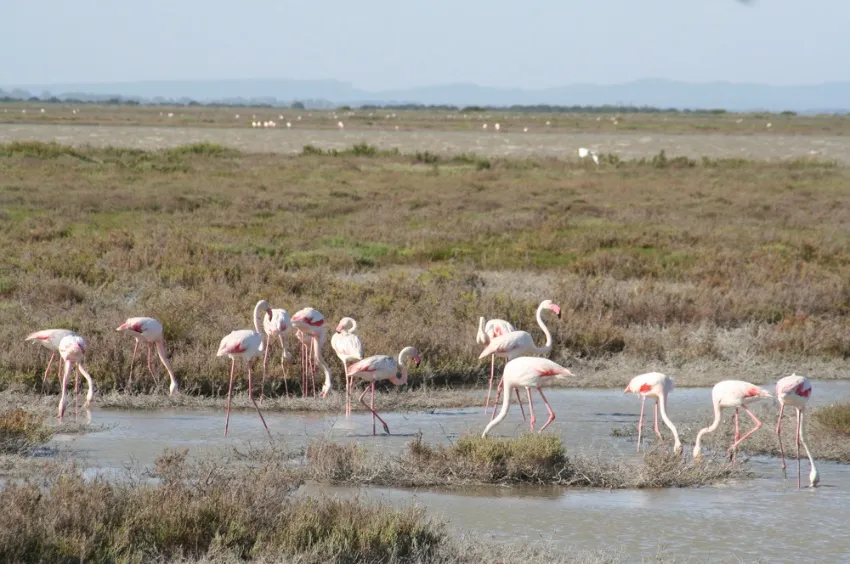
Far from the tourist traps, discover the Petite and Grande Camargue from the back of a jeep with local guides who will share their enthusiasm for this legendary area. You'll cross the Parc Naturel Régional de Camargue, a nationally designated protected area with ponds and marshes that are home to waders, pink flamingos, egrets, herons, etc. Join us for another way to get up and close to nature.
PLEASE NOTE
- PLEASE WEAR COMFORTABLE, STURDY SHOES AND APPROPRIATE CLOTHING ACCORDING TO THE WEATHER.
- The order of the visits can change.
- Times are approximate.
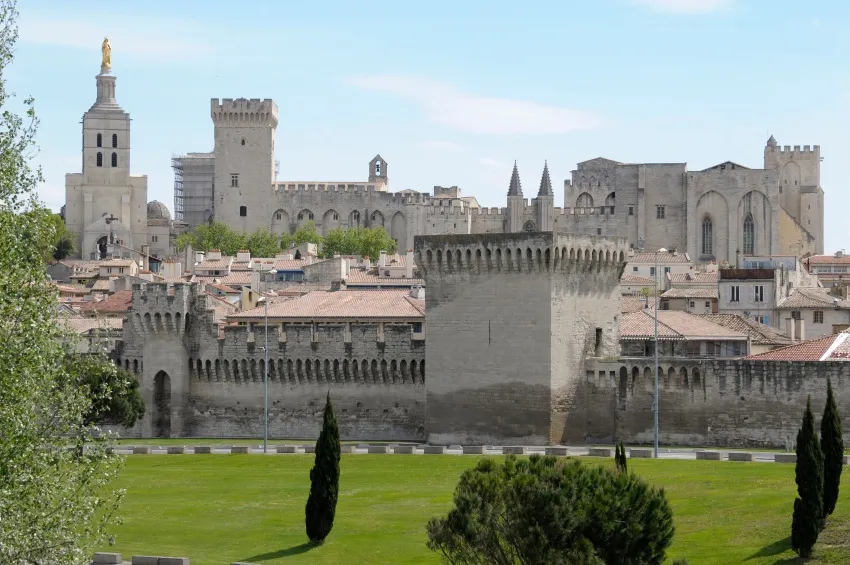
You will set out on foot for the guided tour of the old town of Avignon. With the Pope's Palace, classed as a world heritage site by UNESCO and a testimony to the city's past when it was known as the capital of Christianity back in the Middle-Ages, Avignon offers an impressive array of monuments. Along the Passage de l'Oratoire, you'll be able to admire the exteriors of the chapel, classified as a historic monument, where many events take place during the famous Avignon Festival. We'll move on to St Agricol street where you'll get to see the diocesan Church, the oldest in the city. We'll then stop by the Place de l'Horloge, which has always been the beating heart of Avignon. Cafés and restaurant terraces are now spread out where the Roman forum once stood. Right across, you will see the walls of the Town Hall and the theater that was built in the 19th century. We'll continue to the Place du Palais. This square is roughly 800 ft long and 160 ft wide. To the East stands the Pope's Palace which faces the baroque sculptures of the Papal mint. A large golden Virgin seems to be watching the Notre Dame des Doms cathedral while the elegant Renaissance inspiration on the outside walls of the Petit Palais are showing further back. Then, discover the Pope's Palace, the most important monument in the city. It's made of two parts: the old Palais of Pope Benedict XII (1334 - 1342), and the new Palais of his successor Pope Clement VI (1342 - 1352). Our visit will take you through the staterooms where numerous ceremonies and feasts took place, the chapels, the Pope's private apartments and the terraces which offer a wonderful panorama on Avignon and the Rhône river. Return on board on foot.
PLEASE NOTE
- The order of the visits can change.
- Times are approximate.
- Good walking shoes are recommended.
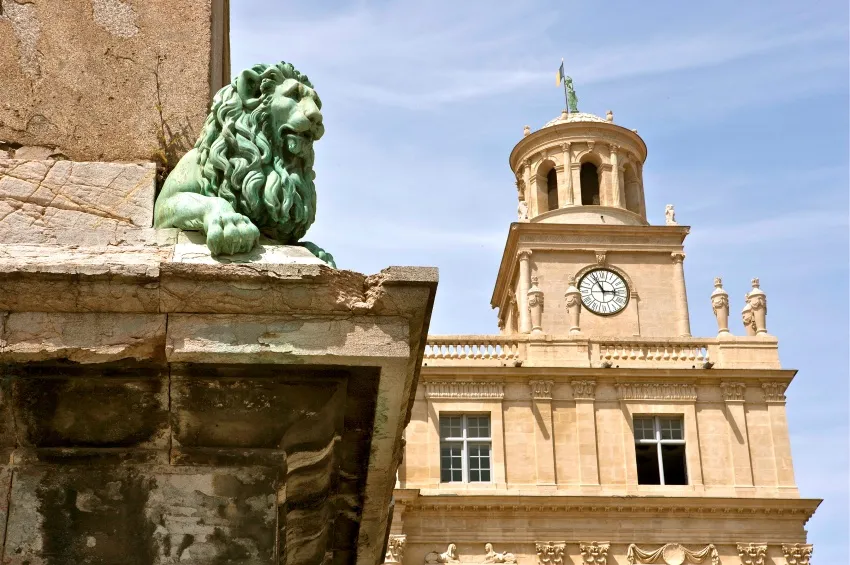
Departure on foot for the guided tour of Arles. Arles with its two thousand years of history has preserved an exceptional monumental heritage, making the city a veritable open-air museum. Welcome to one of the most important tourist and cultural sites in France. During the course of this guided tour you will see the Roman Amphitheatre (the "Arènes"), the Ancient Roman Theatre, Place St Trophime with its cloister and church, which are part of the Arles route, one of the three pilgrimage routes leading to Santiago de Compostela. We will continue our visit with Place du Forum and finally, the Thermae of Constantine. Free time. Return to the boat on foot.
PLEASE NOTE
- The order of the visits can change.
- Times are approximate.
- Good walking shoes are recommended.
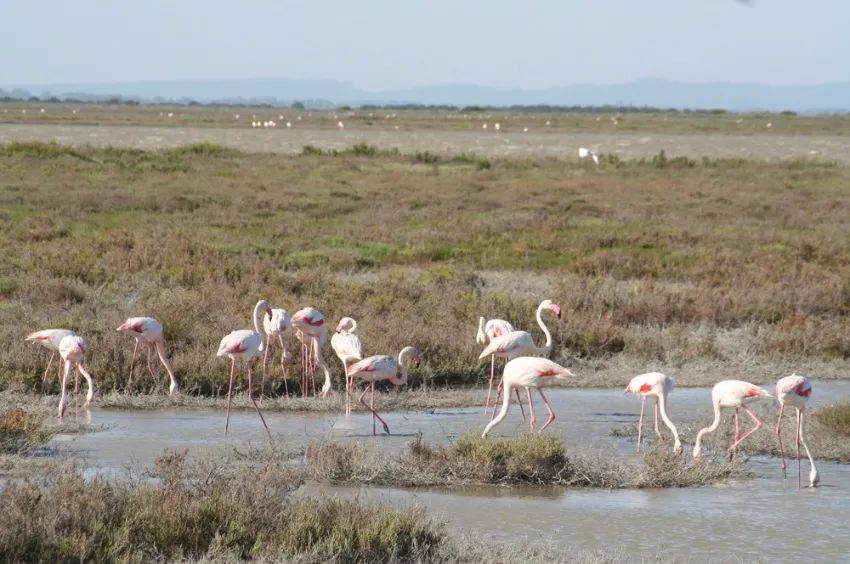
Guided excursion by coach to explore the Camargue. You'll be able to admire its fauna and flora, typical of the Basse Camargue with its swamps and ponds, pink flamingos, bulls and horses as well as the salt marshes and rice fields.
You will then come to the delightful village of Saintes-Maries-de-la-Mer, famed for its gypsy gatherings where you will enjoy some free time before transferring back to the boat.
PLEASE NOTE
- The order of the visits can change.
- Times are approximate.
- Good walking shoes are recommended.
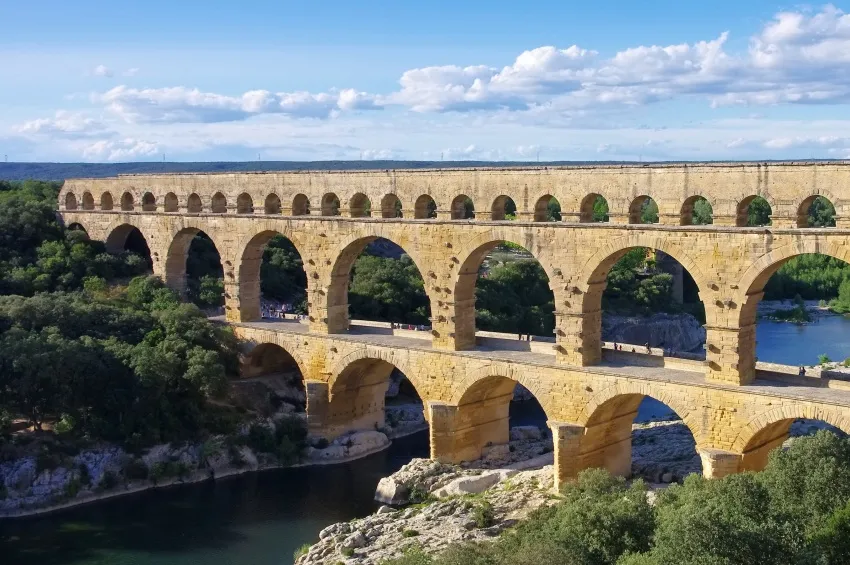
You'll leave by coach for the Pont du Gard, a true masterpiece of ancient architecture. Built as a three-level aqueduct, it carried water across the Gardon River. We'll hike along the aqueduct trail, a 2-mile walk through the site with numerous viewing points. At the end of our trek, we'll visit the museum and then return on board our ship.
PLEASE NOTE
- PLEASE WEAR COMFORTABLE, STURDY SHOES AND APPROPRIATE CLOTHING ACCORDING TO THE WEATHER.
- The order of the visits can change.
- Times are approximate.

Welcome to Tournon! Located in the heart of the Rhone Valley, at the gates of Provence, this city will enchant you with its heady perfumes. We'll begin our visit on foot passing all the main tourist attractions of the town, including the historic monuments and shopping areas.
We'll stop at the Château Museum where we'll get the opportunity to discover the permanent collection tracing the history of navigation on the Rhone river. This imposing castle was built on a high granite rock overlooking the town and was the domain of the barony of the Counts of Tournon. At the foot of the castle, enjoy a pleasant walk along the streets and alleys of the historic center which will take you back to the Middle Ages. Our visit will end with a tasting* of regional products and wines. Return on foot to the boat at our own pace.
PLEASE NOTE
- Comfortable walking shoes recommended.
- The order of the visits can change.
- Times are approximate.
- *Alcohol can be harmful to your health. Please drink in moderation.
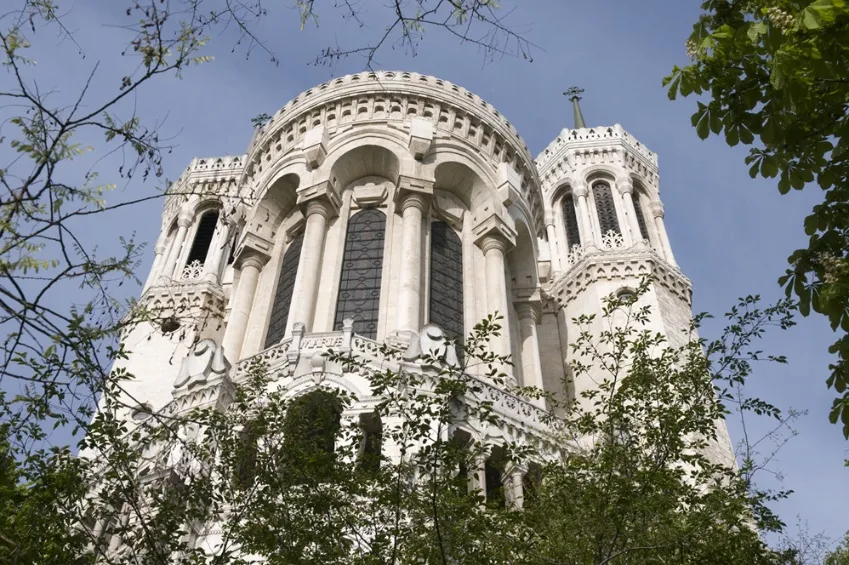
Departure with your guide by coach. First, you will enjoy the magnificent view of Lyon from the heights of the Basilica before visiting its interior. In 1168, a chapel was built at Fourvière by Olivier de Chavannes, Canon of Saint John, on the ruins of the Roman forum. The small chapel, originally dedicated to St. Thomas and later to the Virgin, underwent destructions and reconstructions. The current form dates back to 1740, with the latest renovation in 2008. You will also have the opportunity to visit the crypt of the Basilica, a place of serenity and spirituality, often overlooked but of great historical and architectural significance. This exclusive visit will allow you to learn more about the history and legends surrounding this iconic monument. Return to the coach and continue to Old Lyon. You will take a walk, accompanied by your guide, through Old Lyon to discover the traboules. It is believed that the first traboules were built in the 4th century, when the inhabitants of Lugdunum (the Gallo-Roman name of present-day Lyon) lacking water, moved down to settle in the "lower town," along the Saône River, at the foot of the Fourvière hill. The traboules were used to quickly reach the Saône. Return to the coach for lunch.
PLEASE NOTE
- The order of the visits can change.
- Times are approximate.
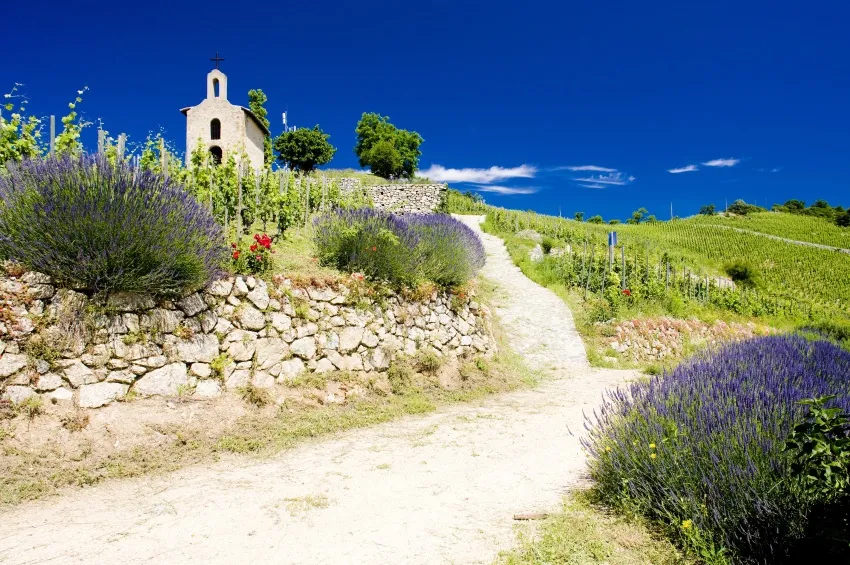
Departure on foot for the visit of a wine cellar in Tain L'Hermitage.
We'll discover the vats, barrels and storehouse and learn all there is to know about wine-making. Afterwards, we'll taste* a white wine (Côte du Rhône Samorens) as well as two red wines (Crozes Hermitage la Martinière and a St Joseph, both produced in this very cellar). Return on board for dinner.
PLEASE NOTE
- It is possible to buy wine after the visit and be delivered on board.
- The order of the visits can change.
- Times are approximate.
- *Alcohol can be harmful to your health. Please drink in moderation.

Enjoy a panoramic guided tour of the Camargue. Sit back and admire the rivers, marshes, ponds, pink flamingoes, black bulls and the famous, indigenous Camargue horses. Discover the salt and rice fields that make the area so well known. We'll visit a manade (bull breeding farm) and learn about the work of a manadier as we watch a demonstration of how they work with the animals they raise. Our visit will include a cocktail on the patio. At the end of our visit, we'll return to the ship.
PLEASE NOTE
- Good walking shoes are recommended.
- The order of the visits can change.
- Times are approximate.
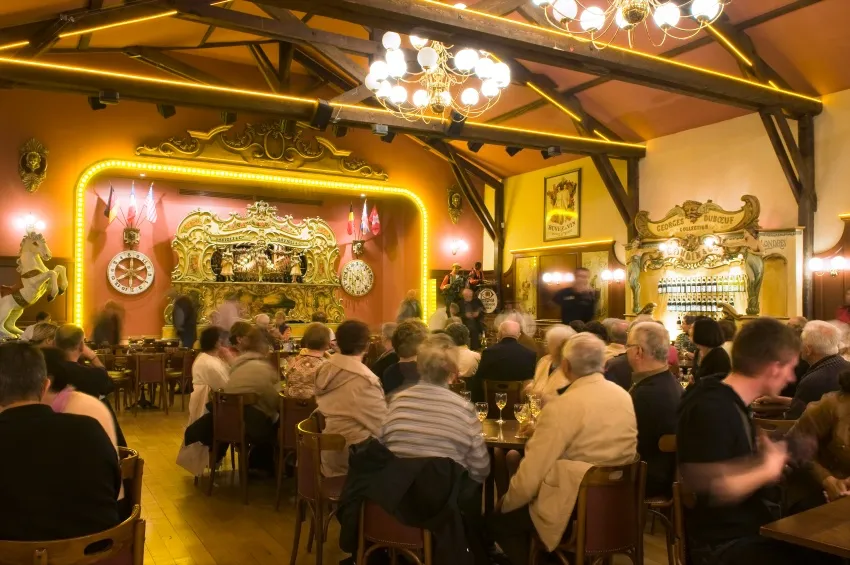
Departure by coach in the company of our guide from Montmerle-sur-Saöne or Belleville to discover the Beaujolais vineyards extending on 22,500 hectares. We will pass through charming little wine-growing villages before reaching Romanèche-Thorins for a visit to the "Hameau Duboeuf ", a unique museum in Europe containing a collection of old and rare objects from over 2000 years of wine-growing history. We'll learn about the current wine-making and vine-growing processes when visiting the wine storehouse where the wines are left to age in oak barrels.
In the midst of the Beaujolais vineyards, we will discover the skills of the winemakers through exhibitions, automated puppet theaters and 3-D films. Afterwards, immerse yourself in fine aromas and delightful scents during a walk through the surprising gardens of "Oenoparc”, a true haven for wine-lovers spread out on 30,000 m² and 25 exhibition halls. Before leaving the "Hameau Duboeuf", we will, of course, enjoy a tasting* of some of the region's wines. Return on board.
PLEASE NOTE
- The order of the visits can change.
- Times are approximate.
- *Alcohol can be harmful to your health. Please drink in moderation.
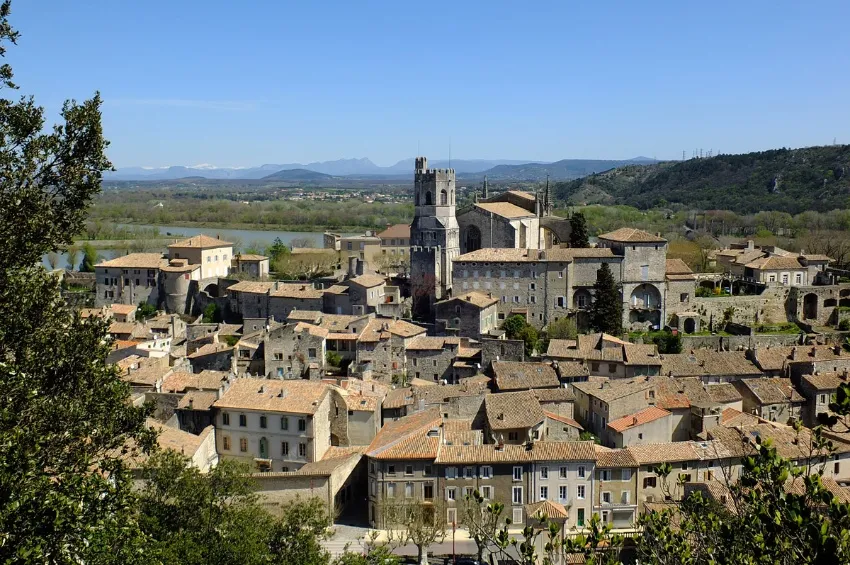
You will leave the boat on foot for the guided tour of Viviers. The third largest protected sector in the Rhône Alpes regions, residence of bishops since the 5th century, Viviers, a small town with a population of 3,500 is like an open-air museum, where every stone contains a page of history. You will be able to admire France's smallest Cathedral in this sumptuous medieval town. Among other things you will see the House of Knights with its superb Renaissance facade, the Tower of St Michael, the great seminary, and the Belvedere with an unobstructed view of Viviers.
Transfer by coach to Montélimar. You will visit a traditional nougat factory, followed by tastings. Since the 17th century, Montélimar has been famous the world over for its nougat, when the first almond trees were introduced into the region by Olivier de Serre and the first harvest led to the development of nougat production. Lively visit to the oldest traditional nougat factory in Montélimar where you can learn all there is to know about nougat - from the traditional methods of production in copper cauldrons and ending with sampling this delightful tasty confectionery. Return by coach to Viviers.
PLEASE NOTE
- The order of the visits can change.
- Times are approximate.
- Good walking shoes are recommended.
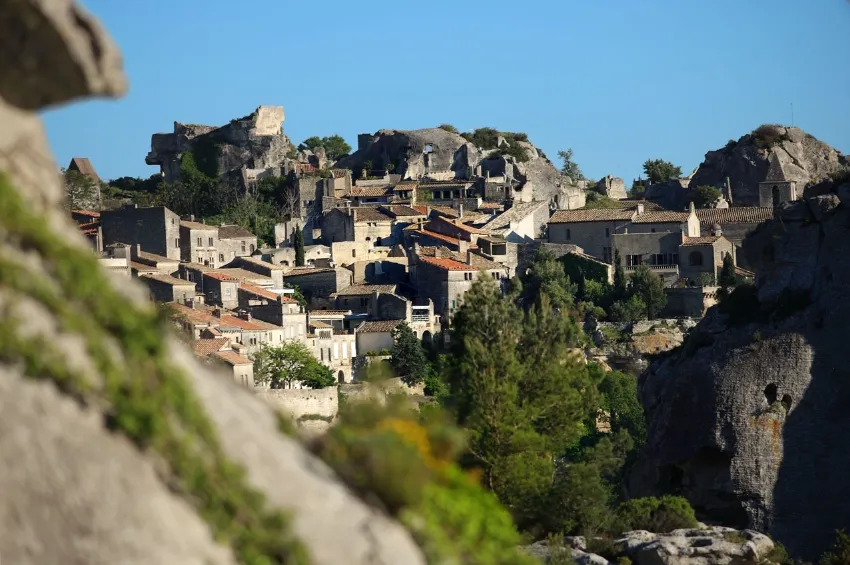
Meet up with your guide and set off on a guided tour of Les Baux de Provence, one of the most beautiful villages in France. Located at the heart of the Alpilles on a rocky plateau, the village overlooks breath-taking landscapes over Arles, the Camargue and the Alpilles. This gorgeous and impressive stone fortress is definitely a must-see.
Tourism developed in this region after World War II with the arrival of Raymond Thuillier who contributed to the worldwide popularity of the Baux with the opening of the gastronomic restaurant "Oustau de Baumanière” where celebrities and political figures would often dine. In 1966, André Malraux issued a decree putting the village under protection of the Ministry of Culture and the Environment. A prosperous era then started for the Baux which had been left aside since the Revolution. The restoration of the city led to its being listed as one of the Most Beautiful Villages in France in 1998. Return on board by coach.
PLEASE NOTE
- Good walking shoes are recommended : Les Baux de Provence is paved and sloped.
- The order of the visits can change.
- Times are approximate.
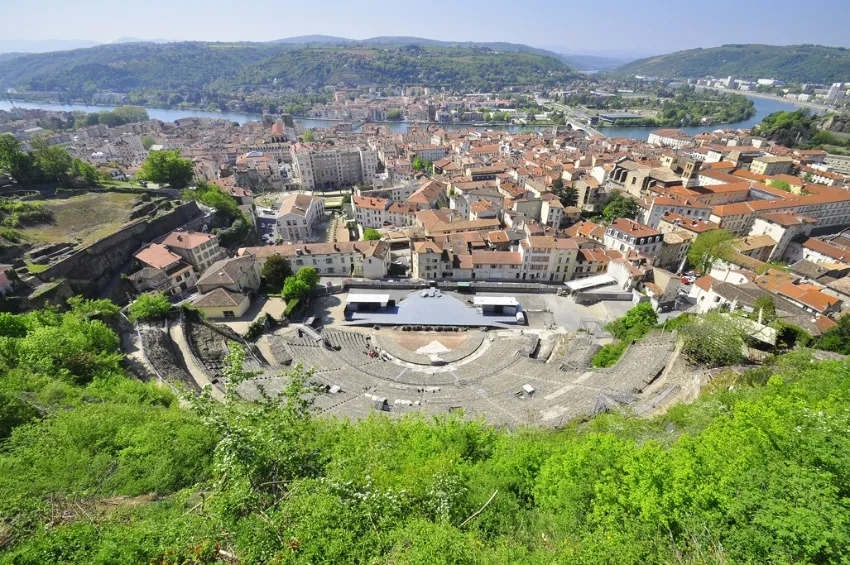
Meet up with the guides for a walking tour of Vienne, during which you will discover this Roman city rich in vestiges. The history of Vienne goes back more than 2000 years. The city is indivisible from the Rhône river and the surrounding hills. The Allobrogi people are thought to have made it their capital, but it was in the Roman era that the city began to prosper on both banks. You will see the Antique Theatre; built roughly between 40 and 50 AD, it is considered one of the largest in the Roman empire, with its 130m diameter and 13,000 spectators capacity. Restored in 1938, it was returned to its original function and is now a venue for artistic events. The tour will continue with the Temple of Augustus and Livia (exteriors only). This temple dedicated to Rome and Augustus stood in a sacred area on the forum and has carried this name since the end of the 18th century. Its construction began about 20-10 BC; it was later transformed at the beginning of the Middle Ages into a church, and was finally restored in the second half of the 19th century thanks to the intervention of Prosper Mérimée. Finally, to complete the tour, you will see the Cathedral of St Maurice (exteriors only), which has been listed as a historic monument since 1840. Return to the boat on foot.
PLEASE NOTE
- Comfortable shoes are recommended.
- The order of the visits can change.
- Times are approximate.
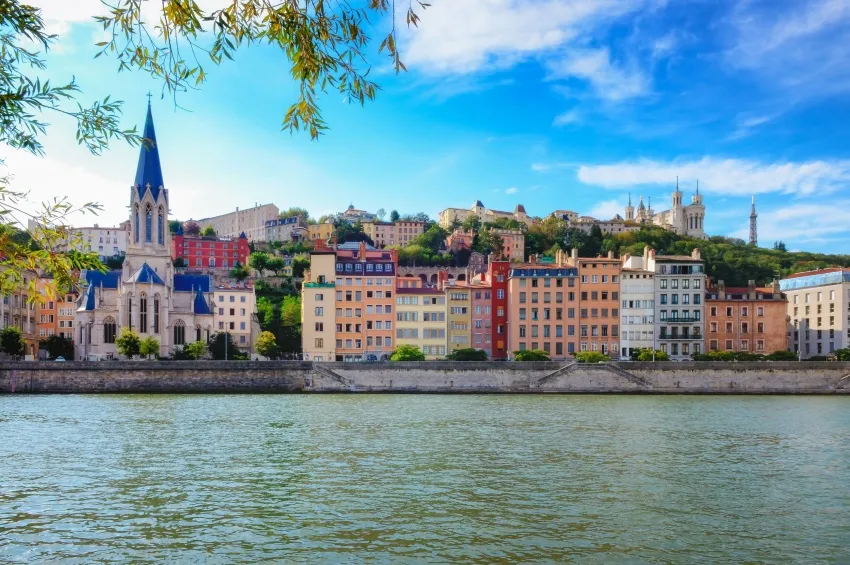
Join us for a guided tour on foot within the heart of Lyon, known as the Presqu’île. What makes this tour unique are the stops at several eateries to have a bite of the local cuisine. The sweet pink praline and savory cold cuts are the stars of this show. We’ll discover the multitude of candies and pastries made with pink praline, a local confection you just can't say no to. For those with a savory tooth, our next stop will be a tasting of regional charcuterie. During this tour, your guide will also talk about renowned local chefs for a complete understanding of the "Gastronomic Capital of the World."
PLEASE NOTE
- Times are approximate.
- The order of the visits can change.
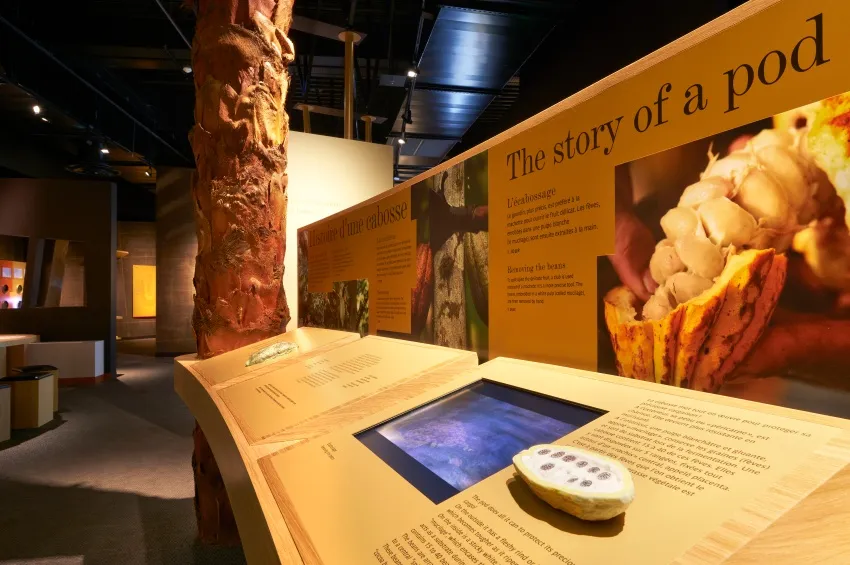
We'll leave on foot for the Cité du Chocolat in Tain l'Hermitage. Come and explore, smell and taste chocolate in all of its forms at the Valrhona discovery center. During the tour of our virtual factory, you'll be invited to take part in short activities about chocolate, and you'll hear from the women and men who help build Valrhona's reputation. Lastly, we'll indulge in a tasting of course! We'll return to the ship on foot.
PLEASE NOTE
- PLEASE WEAR COMFORTABLE, STURDY SHOES AND APPROPRIATE CLOTHING ACCORDING TO THE WEATHER.
- The order of the visits can change.
- Times are approximate.

You will leave the boat on foot for a guided tour of Viviers. The third largest protected sector in the Rhône Alpes regions, residence of bishops since the 5th century, Viviers, a small town with a population of 3,500 is like an open-air museum, where every stone contains a page of history. You will be able to admire France's smallest Cathedral in this sumptuous medieval town. Among other things you will see the House of Knights with its superb Renaissance facade, the Tower of St Michel, the great seminary and the Belvedere with an unobstructed view of Viviers at night. Return to the boat on foot.
PLEASE NOTE
- Comfortable shoes are recommended.
- An effort is required to go up to the Belvedere.
- The order of the visits can change.
- Times are approximate.
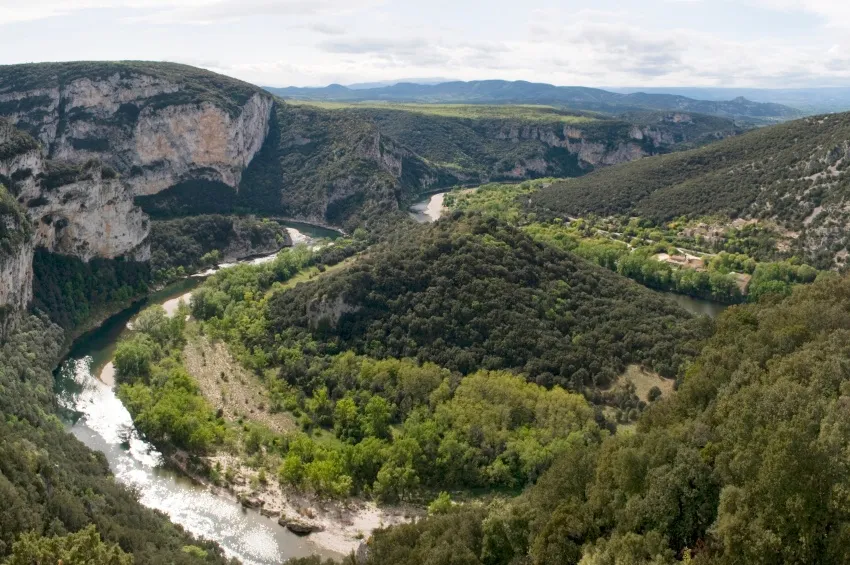
Set off on a panoramic tour by coach to the Ardeche Gorges, an area which abounds with wonderful dramatic and unspoilt natural scenery. Your breath will be taken away by the views of the mountain relief, with steep valleys, dense vegetation, the ever present granite and volcanic rocks, and much more. The Ardeche is a wild untamed river until it reaches Vallon-Pont-d'Arc. Here it bore its way through the rock, creating a huge natural archway - the "Pont de l'Arc” which is some 34 metres high. After a photo stop at an appropriate viewing point, the panoramic tour continues to the Madeleine Cave, where the coach will stop for you to visit the cave. Located in the heart of an area of pure natural beauty, and awarded 3 stars by the famous Michelin Guide, the beauty of the caves has captivated even the most experienced of travellers. The Madeleine Cave is surely one of the most amazing worlds created by underground waters millions of years ago. Return by coach to the boat.
PLEASE NOTE
- As a warning for those suffering from travel sickness, the route during the panoramic tour includes many twists and turns.
- The order of the visits can change.
- Times are approximate.
- Good walking shoes are recommended.
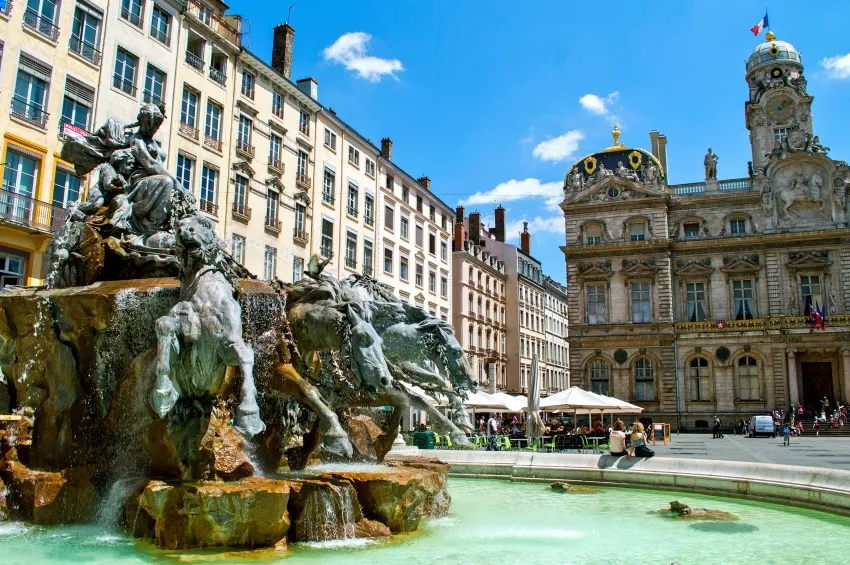
This winkling city will reveal itself to you during a guided visit by coach and on foot. Our excursion will start with a stop at the Fourvière Basilica. You'll first take in the breathtaking views from the heights of the Basilica before entering it. In 1168, a chapel was built in Fourvière by Olivier de Chavannes, the Saint Jean canon, over the ruins of the old roman forum. The small chapel that was first dedicated to Saint Thomas and then to the Virgin Mary has been destroyed and rebuilt many times. Its current known form dates back to 1740 and its most recent renovation was in 2008. After our visit we'll return to the coach and move on to Lyon's Old Town. You will take a walking tour with our guide and discover the "traboules”, types of passageways that are typical of the city. The first traboules are thought to have been built in the 4th century. There was a water shortage in Lugdunum (the Gallo-Roman name that was given to Lyon at the time) that led its inhabitants to settle in the "lower city” on the banks of the Saône, at the foot of the hills of Fourvière. The traboules were thus used to reach the river quickly. You'll enjoy some free time in the Saint Jean district, in the heart of the Old Town. Return on board for lunch.
PLEASE NOTE
- Please dress appropriately to enter the Basilica.
- Good walking shoes are recommended.
- Times are approximate.
- The order of the visits can change.
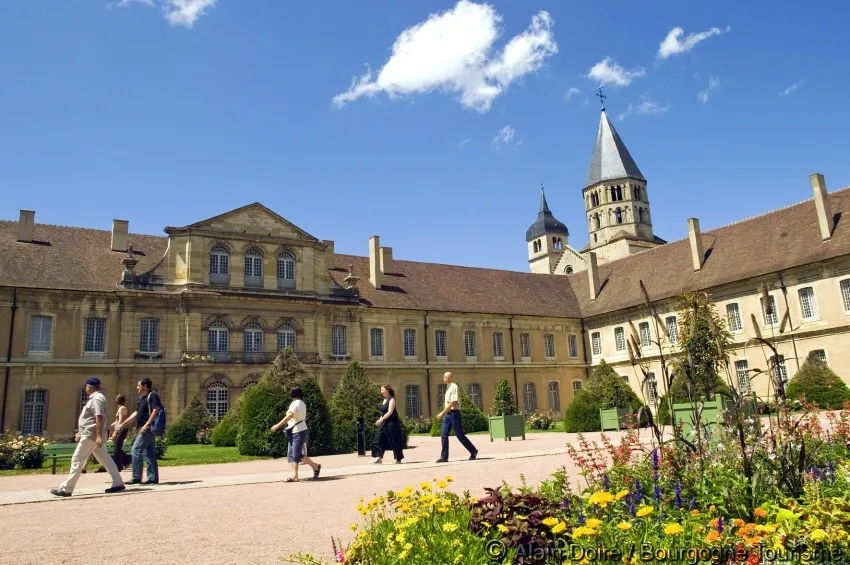
You will leave by coach with your guide to the Cluny Abbey. Founded in 910 by William the Pious, the abbey was under the direct protection of Rome and its abbot was granted the role of mediator between the political leaders and the pope. This ancient Benedictine abbey extended a widespread influence on all of medieval Europe. Its church was the largest in all of West Christianity until the Saint Peter's basilica was built in Rome. In 1798, the abbey was sold as a national asset and thus dismantled, while its church was almost completely destroyed. Today, you can still admire their vestiges which bear witness to the past splendour of Cluny. Return on board in Macon.
PLEASE NOTE
- Good walking shoes are recommended.
- Times are approximate.
- The order of the visits can change.
Departure by coach to Charmes Castle, located in the commune of Charmes-sur-l'Herbasse. You will see gently rolling landscapes, dotted with woods, cultivated fields, and picturesque villages. Upon arrival at the castle, it suddenly appears, perched on a promontory overlooking the valley. This impressive building, dating back to the 11th century, is distinguished by its tall stone towers, battlements, and sturdy walls, testifying to its rich medieval past. The castle has been carefully restored, revealing authentic architecture and details that immediately immerse us in history. In winter, and especially during the Christmas season, Charmes-sur-l'Herbasse Castle transforms into a magical and enchanting place. As you enter the park, the castle is adorned with its most beautiful Christmas decorations and lights. A return to childhood, an immersive visit, as if you were a resident of the castle. Inside, the castle reveals a warm atmosphere, with rooms furnished with period pieces and modern installations that tell the story of its history and restoration. During this festive season, each room is enhanced with Christmas decorations. Every corner of the castle seems wrapped in the magic of the holidays, offering you a full immersion in the Christmas spirit. Discovering Charmes-sur-l'Herbasse Castle at Christmas is a unique experience where historical heritage blends with the magic of the season. To end the visit, treat yourself to a drink offered by the castle. Return by coach.
PLEASE NOTE
- The order of the visits can change.
- Times are approximate.
